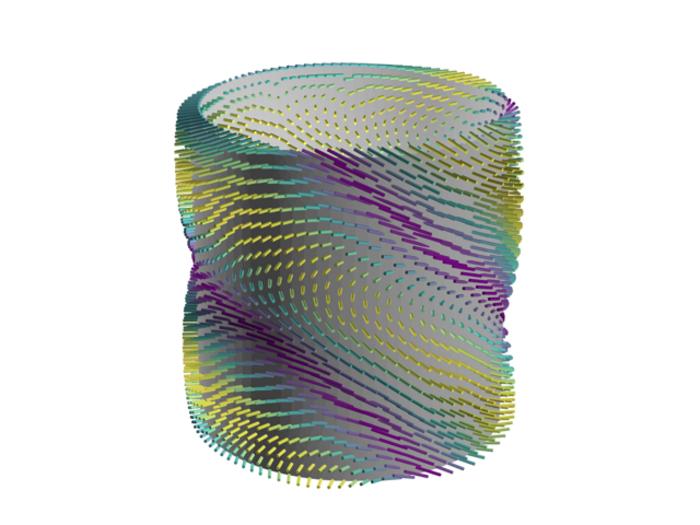
In the landscape of modern engineering and scientific research, the quest for optimal design has become increasingly complex, particularly when it involves soft materials. Traditionally, the realm of structural engineering has relied on well-established methodologies for hard materials, such as metals and concrete. These materials’ predictable behaviors under various loads can be accurately modeled, allowing for the efficient design of structures like bridges, buildings, and machines. However, the introduction of soft materials presents a captivating challenge that demands innovative computational tools and approaches.
In an exciting development, a team of researchers from Tufts University, led by the innovative physicist Tim Atherton, has created Morpho, an open-source software platform tailored for solving shape optimization problems associated with soft materials. This groundbreaking software, recently detailed in the journal Nature Computational Science, promises to democratize access to complex modeling techniques, allowing researchers from various fields to engage with the challenging dynamics of soft and flexible materials. Atherton’s insightful perspective highlights a crucial reality: that many intriguing scientific and engineering problems center on the optimization of shapes. This includes everything from urban planning to the design of advanced medical devices.
Traditionally, engineers and researchers faced significant hurdles when working with soft materials such as biological tissues or specialized membranes. These materials often respond in unpredictable ways to external forces, rendering straightforward calculations inadequate. For example, the design of artificial hearts or stents involves challenges that are not easily addressed through the established practices of rigid material optimization. As such, Morpho emerges as a vital tool that bridges this gap, providing accessible and flexible modeling capabilities that cater to the unique characteristics of soft materials.
The innovative design of Morpho enables users to engage with complexities inherent in soft materials through a user-friendly interface, minimizing the need for extensive preparatory training. Atherton notes the software’s accessibility, pointing out that even undergraduate students can adeptly use Morpho after a brief introduction. This ease of use is critical in expanding the scope of who can engage in this cutting-edge research, thus fostering a broader exchange of ideas and solutions within the scientific community.
To model soft materials, Morpho employs a technique known as finite element analysis. This method involves partitioning a material into smaller, manageable shapes—specifically, two-dimensional or three-dimensional geometries—allowing for detailed modeling of forces, boundary constraints, and material properties. By generating a comprehensive system of equations that describe the interactions within the material, Morpho can predict how these soft structures will behave under real-world conditions.
The ability of Morpho to handle a diverse range of modeling scenarios makes it exceptionally versatile. Not only can it address problems related to soft materials, but it also extends its capabilities to traditional hard materials, making it suitable for a myriad of applications. Whether optimizing the contours of natural landscapes to facilitate traffic flow or developing efficient packing strategies for commercial products, the software stands as a testament to the potential of computational modeling in solving complex engineering challenges.
Membranes and other soft materials often exhibit a chaotic response to external forces, making their design and analysis inherently complicated. For example, a membrane might react to compression, liquid dynamics, or environmental vibrations in ways that are not easily predictable. By employing Morpho, researchers can better understand these responses, leading to improved designs and innovations in fields as diverse as medicine, manufacturing, and robotics.
The increasing interest in soft materials also aligns with broader trends in advanced manufacturing and biocompatible engineering. As industries continue to explore the intersections between biology and engineering, the demand for sophisticated tools like Morpho will likely increase. These tools enable the design of products that are not only efficient but also tailored to the intricate demands of human-centered applications.
Moreover, Morpho does not just cater to academic research; its implications reach into commercial realms as well. The software’s ability to model various packing scenarios offers significant advantages in industries ranging from pharmaceuticals to food and beverage manufacturing. Companies can optimize their logistics and packaging strategies, saving on materials while enhancing efficiency—a key consideration in today’s economy, where sustainability and cost-effectiveness are paramount.
As researchers and engineers embark on the journey to innovate within the realm of soft materials, Morpho paves the way for a reimagined approach to design and optimization. The platform embodies the convergence of computational power and material science, illustrating the potential of modern software to redefine traditional practices. With tools like Morpho at their disposal, the next generation of researchers is poised to tackle challenges previously deemed insurmountable.
At its core, Morpho symbolizes a shift towards inclusivity in scientific and engineering practices. By making complex modeling accessible to a wider audience, it fosters collaboration and sparks creativity. This is especially important in an age where interdisciplinary research is becoming increasingly vital to solve global challenges.
In conclusion, the advent of Morpho marks a significant milestone in the intersection of soft material research and computational modeling. With its innovative design, user-friendly accessibility, and wide-ranging applications, the software is set to become an essential resource for researchers and engineers alike. It embodies a paradigm shift in how we understand and manipulate the materials that shape our world, from the tiniest medical devices to the grandest architectural endeavors.
Subject of Research: Not applicable
Article Title: A programmable environment for shape optimization and shapeshifting problems
News Publication Date: 27-Dec-2024
Web References: Nature Computational Science
References: Not applicable
Image Credits: Credit: Chaitanya Joshi and Tim Atherton
Keywords
Applied sciences and engineering, Computer science, Computational modeling, Materials science
Tags: advanced materials modeling techniquesapplications of soft materials in engineeringcomputational tools for soft materialsdemocratizing access to modeling softwareflexible materials in designinnovative engineering solutionsinterdisciplinary research in materials sciencemodeling soft materials challengesopen-source software for soft materialsshape optimization in engineeringTim Atherton’s contributions to material scienceTufts University research





